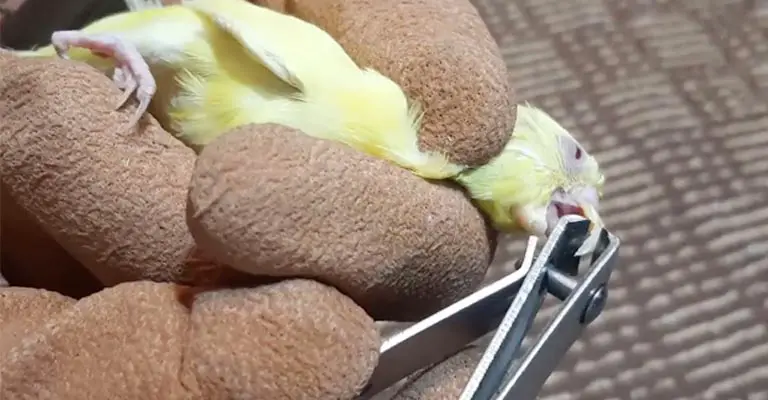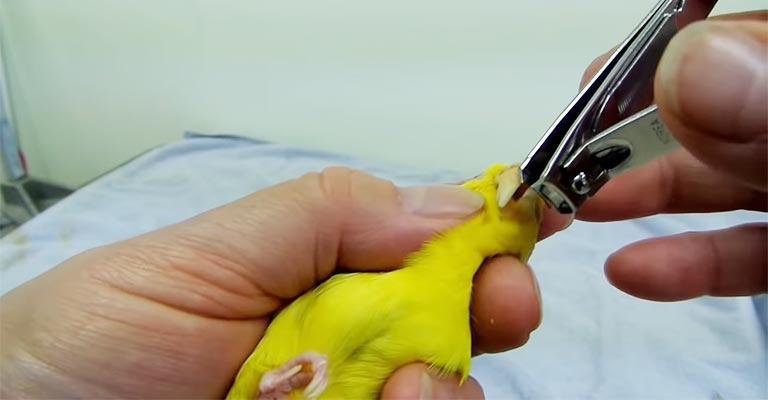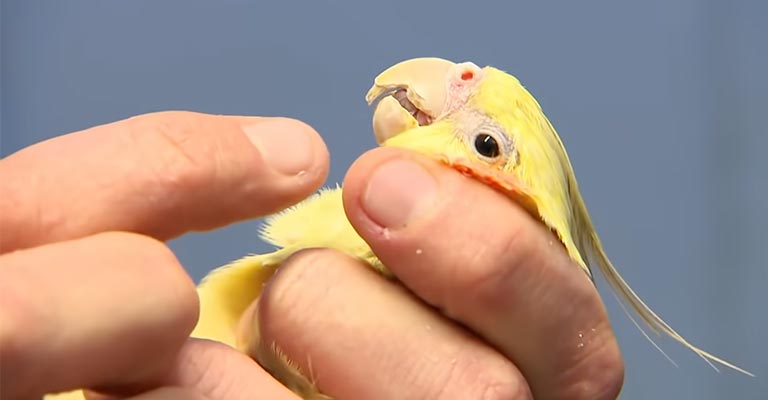Your feathered friend’s beak plays a vital role in their daily life, from eating to grooming and even communicating. Overgrown beaks can lead to various health issues, making regular maintenance essential.
While professional avian veterinarians are the best option, you can also learn how to trim a bird’s beak at home when necessary.
In this comprehensive guide, we will walk you through the steps and precautions required to keep your bird’s beak in tip-top shape. Whether you own a parrot, budgie, or any other bird species, understanding beak care is crucial for their well-being.
We will discuss the tools you’ll need, the signs that indicate a trim is needed, and the correct techniques to ensure your bird’s comfort and safety during the process.
With the right knowledge and a gentle touch, you can become a confident caregiver for your feathered companion.

How to Trim a Bird’s Beak at Home?
Trimming your bird’s beak at home is a responsibility that comes with the territory of avian ownership. It’s important to approach this task with caution, gentleness, and the right knowledge. Here’s how to safely trim your bird’s beak:
Gather the Necessary Tools
Before you start the process, it’s essential to gather the right tools. You’ll need a towel or cloth to gently restrain your bird. A pair of blunt-edged, high-quality bird nail clippers.
A file or emery board to smooth the edges post-trim. Styptic powder or a product like QuickStop in case of bleeding.
Preparation and Safety
Safety should always be your top priority when trimming your bird’s beak. Begin by preparing a quiet, well-lit space where you and your bird can work comfortably. Cover any sharp or hazardous objects in the vicinity to prevent accidents.
Restraint
To safely trim your bird’s beak, you’ll need to restrain them gently. Here’s how to do it. Wrap your bird in a towel or cloth, leaving its head exposed. This will help keep your bird calm and prevent sudden movements.
Hold your bird securely but not too tight. Ensure that it can breathe comfortably, and that its eyes and nares are not obstructed.
The Trimming Process
Now, let’s move on to the actual trimming process. Examine the beak carefully to identify the overgrown areas that need trimming.
Use the bird nail clippers to make a gentle, precise cut, avoiding the sensitive areas and blood vessels (the quick) in the beak. These sensitive areas are often darker and visible, so take care to avoid them.
Trim just a small amount at a time to prevent overcutting. It’s better to make multiple small trims than one large one.
After each trim, use the file or emery board to smooth the edges and prevent sharp points. If you accidentally cut too close to the quick and cause bleeding, apply styptic powder or QuickStop to stop the bleeding. Consult your avian veterinarian if the bleeding persists.
Beak Alignment

In some cases, a bird’s beak may be misaligned, which can affect their ability to eat and perform other essential tasks. If you suspect beak misalignment, consult with your avian veterinarian. Attempting to realign the beak yourself can lead to harm if done incorrectly.
Aftercare and Monitoring
Once you’ve completed the beak trim, provide your bird with a comfortable and stress-free environment. Make sure they have access to food and water.
Regularly monitor your birds in the days following the trim to ensure they are eating and drinking without difficulty. If you notice any signs of distress, consult your veterinarian immediately.
Seek Professional Advice
While this guide can help you understand the basics of trimming your bird’s beak at home, it’s crucial to remember that beak care is a delicate procedure.
If you’re ever unsure about any aspect of the process or if your bird has special needs, consult with a professional avian veterinarian. They have the expertise and experience to handle beak trims and any associated complications.
When to Trim a Bird’s Beak?

Knowing when to trim a bird’s beak is crucial for the overall health and well-being of your feathered friend. Be vigilant about observing any signs of overgrowth, uneven wear, difficulty eating, or beak injuries.
Regular inspections and professional guidance are key to providing the best care for your bird. Here are the details:
Overgrown Beak
One of the most common reasons for trimming a bird’s beak is overgrowth. A beak that has become too long can lead to several issues.
Overgrown beaks can make it challenging for birds to eat, grasp objects, and preen themselves effectively. This can result in malnutrition, and discomfort, and even affect their overall quality of life.
To identify an overgrown beak, observe your bird’s beak from the side. It should have a relatively straight and natural shape, with the upper and lower parts of the beak meeting properly. If the beak appears excessively long or curved, it’s a clear sign that it requires attention.
Uneven Beak Wear
Another reason to trim a bird’s beak is uneven wear. In the wild, birds use their beaks regularly to forage, manipulate objects, and engage in various activities.
However, in captivity, some birds may not have the same opportunities for natural wear and tear. As a result, one side of their beak might wear down more than the other, causing an imbalance.
Uneven beak wear can affect a bird’s bite and make it challenging for them to grasp and handle food. If you notice that your bird’s beak is visibly uneven or misaligned, it’s an indication that a trim may be necessary.
Difficulty Eating
Birds use their beaks not only for manipulating food but also for breaking it down into smaller, manageable pieces. If your bird is struggling to eat, it could be due to beak-related issues.
They may have difficulty grasping and breaking apart food, which can lead to weight loss, malnutrition, and overall health problems.
If you observe that your bird is having trouble with their food, it’s time to consider a beak trim. Addressing the issue promptly can help them regain their ability to eat comfortably.
Beak Injuries
Injuries to a bird’s beak can occur due to various reasons, such as accidents, fights with other birds, or using their beak inappropriately, like biting on metal cages. Beak injuries can range from minor chips and cracks to more severe damage.
Any visible damage to the beak should be addressed promptly. Neglecting beak injuries can lead to further complications, including infections.
In such cases, beak trimming may be necessary, but it’s crucial to consult with a professional avian veterinarian to determine the best course of action.
Beak Abnormalities
Some birds are born with beak abnormalities or congenital defects. These can include beaks that are too long, misshapen, or deformed in some way.
Beak abnormalities can affect a bird’s quality of life, making it challenging for them to eat, preen, and engage in normal behaviors.
If your bird has a congenital beak abnormality, working closely with an avian veterinarian is essential. They can provide guidance on managing the condition and, in some cases, may recommend periodic trims or other interventions to ensure your bird’s well-being.
Routine Beak Maintenance
While some birds may require beak trims due to specific issues, many birds can maintain their beaks naturally through regular activities such as chewing on natural perches, manipulating toys, and foraging.
Providing your bird with these opportunities for natural beak wear can help prevent the need for frequent trims.
Regularly inspect your bird’s beak as part of their overall health care routine. This will help you catch any issues early and take action before they become severe. If you’re uncertain about the condition of your bird’s beak, consult with your avian veterinarian for guidance.
Take Expert Advice
In many cases, determining when to trim a bird’s beak requires the expertise of a professional avian veterinarian. They can assess your bird’s specific needs, recommend the appropriate trimming schedule, and perform the procedure safely and effectively.
If you’re unsure about whether your bird’s beak needs trimming or if you’re not comfortable performing it yourself, it’s always safe to take an expert’s help.
FAQs
Is it safe to trim my bird’s beak at home?
Trimming a bird’s beak at home can be safe if done correctly and with the right tools. However, it’s important to consult with an avian veterinarian for guidance, especially if you’re a beginner.
What tools do I need to trim my bird’s beak at home?
To trim a bird’s beak at home, you’ll need a towel or cloth to gently restrain your bird, high-quality bird nail clippers, a file or emery board to smooth the edges, and styptic powder or a product like QuickStop in case of bleeding.
How often should I trim my bird’s beak at home?
The frequency of beak trims depends on the individual bird. Some birds may require trims every few months, while others may go longer between trims.
Can I trim my bird’s beak if it has an injury or deformity?
If your bird has a beak injury or congenital deformity, it’s best to consult with an avian veterinarian. They can assess the specific condition and recommend the appropriate course of action.
What should I do if I accidentally cut my bird’s beak too short and it bleeds?
If you accidentally cut your bird’s beak too short and it starts bleeding, apply styptic powder or a product like QuickStop to stop the bleeding.
Conclusion
Learning how to trim your bird’s beak at home is an invaluable skill for any responsible avian owner.
A well-maintained beak ensures that your bird can eat, preen, and communicate effectively. While professional veterinary care is always recommended, there are situations where a home trim may be necessary.
Throughout this guide, we’ve emphasized the importance of safety, patience, and gentle handling when performing a beak trim.
Remember to regularly inspect your bird’s beak for signs of overgrowth or damage and consult with a veterinarian for guidance if you’re unsure about the procedure.
Always prioritize your bird’s comfort and well-being, and consider seeking professional help if you ever feel uncertain about performing a beak trim at home. Your commitment to their health and happiness will strengthen the bond you share with your avian companion.